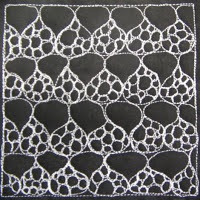Day 129 – Honeycomb
I feel like I haven’t been stretching my variation muscles lately so let’s see what we can do!
Here’s one variation mixing Lacy Lattice with Pebbling to create Honeycomb:
 I realize my written instructions for blocking a quilt might have confused some of you. Let me set the record straight on a few things about blocking:
I realize my written instructions for blocking a quilt might have confused some of you. Let me set the record straight on a few things about blocking:
- Blocking isn’t REQUIRED for bed quilts. It’s not really necessary, but it is a good idea to at least square the sides and corners before binding.
Blocking helps to make your quilt hang well on a wall. If you remember this goddess quilt, I made 2 mistakes with it – first I quilted it inconsistently (really dense in her body, really open in the background), then I never blocked it.
The quilt has never hung well and was a real frustration. I also didn’t pre-wash my fabric back then, so I can’t get her wet to block her.
So those are the reasons to block a quilt – if it’s a bed quilt you want to potentially show and have hang well or if it’s a wall hanging that needs to always hang well.
With that out of the way, let’s learn how to stitch Honeycomb:
Difficulty Level – Advanced. This isn’t a super tough design, but it does require a lot of fine tuned movements. Just make sure to stay right on top of your stitching as you travel so the pebbles come out very clear.
Design Family – Edge to Edge. This design is stitched from one edge of your quilting space to another. This means that this design will work really well in most open, uncomplicated areas of your quilt.
Directional Texture – Two directions. This design has a very obvious horizontal or vertical texture that can add a nice movement to your quilt without being too overwhelming.
Suggestions for Use – I’m thinking about using this Honeycomb design on a large scale with my next show quilt. This little bit of fun texture is sure to add a nice touch to the inner and outer boarders of the quilt.


Your block looks like lace. Very beautiful!
When you mentioned an option to switch to a "thinner, stronger" thread, do those two (thinner, stronger) typically go together? i.e., how does one go about gauging the strength of thread? I know for cotton thread, as the number goes higher, the thread gets thinner (12, 30, 40 etc.). Is strength of thread more related to the type of thread (poly, nylon, cotton)?
Thanks!
Hi Judy – I really don't think there is any standard way of gauging a thread's strength without simply trying it.
Typically I've found that the thinner you go with a natural thread (cotton, silk, etc) the weaker it will get.
But the same isn't true for synthetic threads. The best thin, strong thread I've found is Isacord and that's pretty much all I use now.
Really you just have to try it and test the thread with an intense design like this one to see if it can take the heat.
If the thread breaks or shreds on you, it's just not going to work.
I hope that helps!
Leah Day